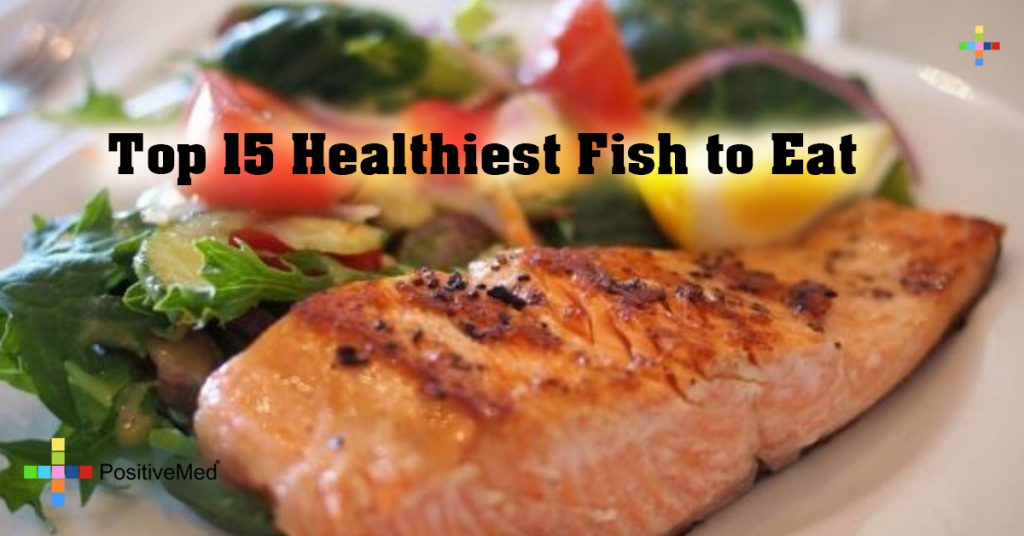
Fish is one of the best foods you can eat: they are one of the best sources of omega-3 fatty-acids, as well as many other nutrients most people don’t get enough of. Eating fish has been proven to increase grey matter in the brain, preventing age-related deterioration. It has also been proven, in some cases, to ease Depression; the omega-3 fatty-acids not only make the brain healthier, but they also improve the effectiveness of anti-depressants. Fish are also a great protein source, one of the most important nutrients many people do not get enough of the day-to-day. But what is the best fish to eat? How do you find out which fish are the healthiest to eat, when so many options are available? When you go to buy fresh seafood, there are easily hundreds of options. Below is a top 15 list of healthiest fish to eat, as proven by scientific research.

1. CATFISH
Catfish is high in omega-3 fatty acids, which improve brain health, prevent heart disease, and protect your eyesight, as well as many other health benefits. It also has selenium, which increases metabolism. Avoid Catfish from overseas, though; if not raised in the right conditions, catfish can contain high levels of carcinogens. So make sure your Catfish is American.
2. OSCIETRA
Oscietra, also known as sturgeon caviar, is packed with vitamins and minerals; per one ounce, you get 93% your daily recommended value of B12, which is essential for nerve health and also provides energy. It also has vitamins A and E, as well as B6, Riboflavin, Thiamin, and many others. Some might avoid oscietra because of its price, but for the nutritional value, the price could be well worth it.
3. TUNA
Tuna is another fish with very high omega-3 content, which makes it great for heart health. Tuna is also packed with protein; in a single serving, you get about 80% your daily value of protein. Avoid it canned, though; canning reduces vitamin content, as well as changing the texture and taste of the fish. The fresh variety is more nutritious, as well as tastier.
4. ROCKFISH
Rockfish is another great protein source, with about 33 grams of protein per serving. Rockfish is also a great low-calorie option, as it is only about 160 calories per serving. These two facts together mean that it will certainly make you feel full without being full of calories.
5. FLOUNDER
Flounder is a member of the flatfish family, which are all both low-fat and low-calorie. They are also very low-fat and packed with vitamins, making this one of the healthiest fish to eat. Other members of the flatfish family include Sole and Halibut, which have the same nutritional value.
6. SALMON
When considering what is the best fish to eat, definitely consider Salmon. They are rich in healthy fatty acids, protein, and vitamins. It is important to look for wild-caught salmon as opposed to farmed; the farmed variety is less nutritious, and the many health benefits, such as an increased lifespan and better joint health, will only be found in the wild-caught variety.
7. SABLEFISH
Sablefish is the family of fish commonly known as cod. It is full of vitamins and essential fatty acids but is extremely oily. It is still a great source of vitamins, but you may want to consider your tolerance for oily foods when considering this as one of the best fish for you.
8. SARDINES
When going to buy fresh seafood, sardines can be harder to find. They are, however, one the healthiest types of fish there are. They are rich in omega 3 fatty acids and vitamin B12, which promotes energy and overall health.
9. TROUT
If trout is your fish of choice, it is recommended to be consumed every other week to promote heart health. It is full of omega 3, and is considered a great alternative to red meat. Freshwater variety is best in the case of trout.
10. CRAYFISH
Crayfish make a great healthy snack. A serving contains only 70 calories, 14 grams of protein, and is low in cholesterol, as well as having all the benefits of omega 3 fatty acids. As with catfish, make sure your crayfish are from America.
11. CRAB
Fresh crab is rich in nutrients and protein, and is a great low-calorie food. It is also very easy to find, but stay away from canned or artificial crab; it can be very high in sodium, too much of which causes water weight gain, and is not good for cardiovascular health.
12. SCALLOPS
Scallops make this list of healthiest fish to eat because they are another great high-protein, low calorie fish; one serving of scallops, about 3 ounces, contains only about 90-100 calories and 20 grams of fat.
13. MUSSELS
Mussels are rich in iron, which is needed to prevent anemia and promote high energy, and zinc, which promotes immune health. They are also a convenient meal, as they only take 3 minutes to fully cook.
14. ARCTIC CHAR
This fish is a relative of trout, one of the best fish to eat, as well as one of the healthiest types of fish, in the world. It has all the same health benefits, but in this case, look for the farmed variety; the waters the wild variety of this fish come from are not too clean.
15. LONGFIN SQUID
Longfin squid is one of the best fish to eat; they are rich in omega 3 and vitamin B12, both essential in promoting overall health and preventing mental illnesses like Depression. Low in calories and contains no carbohydrates, as long as they are not deep-fried, longfin squid is one the healthiest fish to eat.






